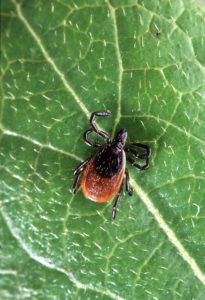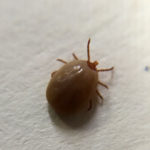Dogs and Lyme disease is fairly common in dogs. It can happen anywhere in the United States, but the highest area of occurrence is in the Northeast, the Upper Midwest and the Pacific Coast.
Table of Contents
What Is Lyme Disease
Lyme disease is a bacterial illness that can be transmitted to dogs by a certain species of ticks. It is caused by the spiral-shaped bacterium Borrelia Burgdorferi that is carried inside a tick. It gets in your dog’s bloodstream from a tick bite.
When it is in the bloodstream, the bacteria travels to different parts of the body. It can cause problems to your dog’s organs, joints and your dog’s overall health.
How Do Dogs Get Lyme Disease
Dogs get Lyme disease when they receive a bite by a tick that is carrying the disease. The primary carrier of Lyme disease is the Black Legged Tick also known as a deer tick or bear tick.

An adult deer tick
The tick will get the disease when it feeds on an animal that is infected such as a deer or mouse or other mammal. It then transmits the disease when it feeds on the next animal.
The ticks are mostly found in tall grasses, thick brush, marshes and in the woods. The ticks are waiting on top of the grasses or brush until something goes by them. They then attach themselves to your dog or you.
Not all ticks attach to your dog nor are all ticks infected with the bacteria that causes Lyme disease. The disease can be transmitted once an infected tick is attached to your dog for 24 – 48 hours.
A tick will feed on your dog until it swells to 10 times its original size. They could easily be attached to your dog for 3 months or longer.
Ticks are active starting in temperatures just above freezing, so it is best to keep your dog protected from ticks all year long.
Symptoms Of Dog Lyme Disease

An engorged deer tick.
Dogs do not get the red rash with a clear center or the bulls eye that many humans have been known to get when they get infected with Lyme disease, so it is somewhat harder to detect when your dog has Lyme disease.
Symptoms of Lyme disease for a dog will start somewhere between 2 – 5 months after the infection. By the time that you see the symptoms in a dog, they are already infected.
- Fever – the best way to know if your dog has a fever is by their nose. It is usually cold and moist. When it is dry and warm, they could have a fever.
- Loss of appetite.
- Reduced energy
- Lameness. This is the one to watch. Many things can cause lameness with dogs, but if your dog is having on and off lameness, or if the lameness is switching which leg is lame, it is a good sign that your dog is displaying symptoms of Lyme disease.
- Stiffness, discomfort or pain. Again, watch if this comes and goes or changes.
- Swelling of the joints.
- Enlarged lymph nodes.
- Arthritis is one of the most common signs of Lyme disease.

- Can progress to kidney failure.
- Can have neurological effects.
Treatment Of Dog’s Lyme Disease
A large problem with Lyme disease is actually getting it diagnosed. There are many symptoms that are similar to other diseases. Usually, your dog won’t get diagnosed with Lyme disease until all other diseases have been eliminated.
There are 2 types of blood tests that your dog can be given to determine if your dog has Lyme disease. The first test is an antibody test which detects the presence of specific antibodies that form if your dog was exposed to the bacterium. Positive test results means that your dog has been exposed.
There are some problems with the results. Recently infected dogs might not have high enough levels of antibodies to show up in the test. Dogs that have been infected for a long time, also might not have enough antibodies left to show positive test results. This is where the test results can give you a “false negative” result.
The second test is a polymerase chain reaction or PCR. A DNA test is checking the presence of bacterium. You can also get a “false negative” result if bacteria is now located in your dog’s joints and no longer in the blood cells.
Your dog will be given antibiotics for several weeks if it is determined that your dog has Lyme disease. You will usually see some improvements in your dog within 3 – 5 days, but your dog will likely take the antibiotics for about a month.
Your dog can go into remission, but can suffer random flare-ups of symptoms for the rest of their lives.
How To Prevent Lyme Disease
There are ways to prevent your dog from ever getting Lyme disease. Inspect your dog after being outdoors. Look your dog over carefully including between toes, under and in ears and the entire body. Removal of ticks before they ever attach is your best protection.
Avoiding long grass, shady areas, brush and the woods will put your dog less in danger of coming in contact with

Long green grass is where ticks live
ticks, but that isn’t always possible with depending on where you live, or the breed of dog that you have. Some dogs just really love getting into the long grass to investigate.
There are several choices when it comes to protecting your dog from Lyme disease.
There is a Lyme disease vaccination. This vaccination would be given initially twice to your dog. They would receive the original vaccination and then 2-3 weeks later, your dog would receive a booster shot. After that, your dog would need an annual vaccination. It is best to speak with your veterinarian whether this is the best protection for your dog.
You also have the option to use some type of topical tick protection. This is generally applied to your dog on their skin between their shoulder blades. Frontline would be an example of a topical protection. I do find an issue with topical products. This will only work for killing the tick your dog brings into your home if the tick bits your dog. Otherwise, the ticks that don’t attach to your dog will be walking around your home looking for someone to attach to. This application needs to be applied monthly.
Lastly, there are the tick and flea collars. These are no longer the type of collars from long ago. Most will provide protection for 6 months or longer. From my personal experience, they work great. I have always had problems with 2 Golden Retrievers and ticks. With the topical application, I would easily pick 30 ticks a day off of each dog that they would bring into the house.
Since I have switched to using a collar, I have very rarely found any ticks on my dogs. It works much better than the topical application. The collar that I have been using that is working great is a Scalibor Flea and Tick collar.
If your dog does get a tick attached to his skin, you need to remove as soon as you locate. Remember, they can be attached for 24-48 hours before they actually transmit Lyme disease.
Remove the tick as close to the head as possible. If parts of mouth break off and remain in the skin, your dog still has a chance of getting an infection. Pull directly up using a tweezers and avoid twisting.
Summary
Dogs and Lyme disease may be an unavoidable risk your dog may face. Inspect your dog every time they have been

Check your dog over after they are in long grass.
outdoors where ticks could be possible. Use some type of tick protection for your dog in case they do encounter ticks, and know what the symptoms of dog Lyme disease are so you know if your dog should be tested for Lyme disease.
Tick bites can also lead to your dog possibly getting hot spots from the skin irritation the bite will cause. Another reason to make sure your dog is always protected from ticks.
Please leave any questions or comments below and I will get back to you. If you found this article valuable, you can follow us on Pinterest, FaceBook or Google+ below.
Some of the links within this post are affiliate links of which I might receive a small compensation from sales of certain items.

This is a good post not only for dog lovers but for all of us whoever has a dog at home as a house guard.
Diseases and infirmities of dogs directly reflect the owners’ care and service.
And this kind of article comes into play for such remedies.
You have done a good job and I look forward to reading more such articles.
Wishing you a HUGE Success.
Reply
Thank you so much for reading and I’m glad you found the article value. Lyme disease precautions are good not only for your dogs, but any animals you have along with keeping yourself safe.
Reply